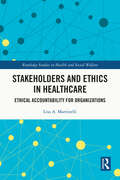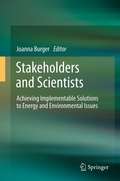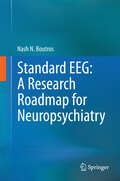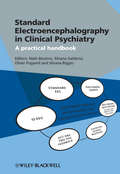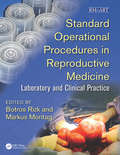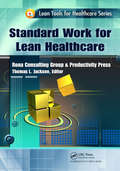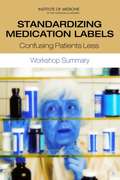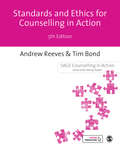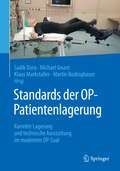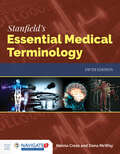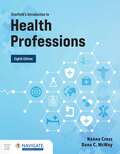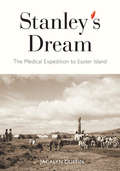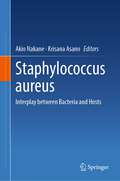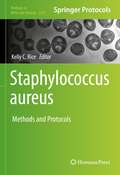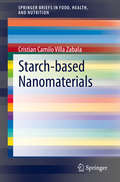- Table View
- List View
Stakeholders and Ethics in Healthcare: Ethical Accountability for Organizations (Routledge Studies in Health and Social Welfare)
by Lisa A. MartinelliThis ground-breaking book uses organizational ethics and stakeholder theory to explore the ethical accountability of leadership in healthcare organizations to their distinct vulnerable stakeholder communities. The book begins with a discussion of the moral agency of healthcare organizations and introduces stakeholder theory. It then looks at key ethical challenges in relation to the confidentiality and privacy of health care data, before turning to child health and interventions around issues such as obesity, maltreatment, and parenting. The book ends by focusing on ethics of care in relation to older people and people with disabilities. An insightful contribution to thinking about ethics for contemporary healthcare management and leadership, this interdisciplinary book is of interest to readers with a background in healthcare, business and management, law, bioethics, and theology.
Stakeholders and Scientists
by Joanna BurgerNation and the World must move forward with development of a range of energy sources and savings, all with attendant environmental problems. Solving these problems, and those remaining from past energy-related activities, will require iteration, inclusion, and collaboration with a wide range of stakeholders, including U.S., State and local governmental agencies, Tribal Nations, scientists, environmentalists, public policy makers, and the general public.
Stalking Crimes and Victim Protection: Prevention, Intervention, Threat Assessment, and Case Management
by Joseph A. DavisAlthough stalking is an age-old phenomenon, it is only recently receiving due attention. In a span of just ten years, all fifty states have passed anti-stalking legislation. For the first time, Stalking Crimes and Victim Protection: Prevention, Intervention, Threat Assessment, and Case Management brings together in one source all the research done
Stammzellen: Neueste Fortschritte
by Khawaja H. HaiderIn diesem Band berichten die Autoren aus führenden Labors, die sich mit Stammzelltheranostik beschäftigen, über die neuesten Fortschritte auf dem Gebiet der Stammzellforschung. Das Buch befasst sich mit vielen Aspekten der stammzellbasierten Therapie und den Fortschritten in der Stammzelltherapie bei Leber-, Augen- und Herz-Kreislauf-Erkrankungen sowie bei Krebs. Dieser Band ist eine Fortsetzung der von Prof. Khawaja Husnain Haider bereits herausgegebenen Bücher zur stammzellbasierten Therapienostik. Es ist ein ideales Buch für Forscher, die sich mit der Entwicklung von Arzneimitteln sowie mit regenerativer Medizin und stammzellbasierter Therapie beschäftigen. Die sekundäre Zielgruppe umfasst Medizinstudenten, Ärzte, Zellpharmakologen, die Arzneimittelindustrie und Forscher, die Stammzellen als Ex-vivo-Krankheitsmodelle für die Arzneimittelentwicklung verwenden.
Stand By Me: A Guide to Navigating Modern, Meaningful Caregiving
by Allison J. Applebaum&“Warm, compassionate, and brimming with wisdom and expert advice&” (Kate Washington, author of Already Toast), Stand By Me provides caregivers with new ways to juggle the responsibilities and emotional ups and downs of caregiving.As the founder of the only devoted Caregivers Clinic in the country, clinical psychologist Dr. Allison Applebaum is no stranger to the intensity of being an unpaid, untrained family caregiver. She also understands that it is often the strength and well-being of these very caregivers—the parents, children, partners, siblings, and friends of patients—that are the true linchpin determining each patient&’s illness experience. Stand By Me puts the practical tools and transformative support of the Caregiver Clinic in your hands, empowering you to provide your loved one with the best quality of life and care possible, while promoting your own well-being. The book covers crucial topics including: -Getting the most from any healthcare system -Productive advance care planning -Navigating changing roles and relationship dynamics -Finding meaning and purpose in the caregiving experience Stand By Me draws on more than a decade of clinical and research experience as well as Dr. Applebaum&’s personal journey as the primary caregiver for her own father, legendary musician Stanley Applebaum, at the end of his life. Dr. Applebaum recognizes caregivers for who they truly are: invaluable healthcare team members. Offering critical insight and takeaways, Stand By Me is &“a rich resource of invaluable information and expert advice for caregivers&” (Dr. Kathleen M. Foley, Emeritus Professor of Neurology, Weill Cornell Medical College).
Standard EEG: A Research Roadmap for Neuropsychiatry
by Nash N. BoutrosThis volume is designed to serve as a reference source containing both historical and recent references with a special focus on the existing gaps of knowledge regarding EEG deviations in psychiatric populations. Every chapter begins by outlining the clinical issues, then reviews available literature and concludes by highlighting a) currently supportable findings, and b) open research questions. In some chapters the author makes suggestions regarding the research design that will most likely lead to generating data that can move the field towards resolving unresolved issues.
Standard EEG: A Research Roadmap for Neuropsychiatry
by Nash N. BoutrosThis volume is designed to serve as a reference source containing both historical and recent references with a special focus on the existing gaps of knowledge regarding EEG deviations in psychiatric populations. Every chapter begins by outlining the clinical issues, then reviews available literature and concludes by highlighting a) currently supportable findings, and b) open research questions. In some chapters the author makes suggestions regarding the research design that will most likely lead to generating data that can move the field towards resolving unresolved issues.
Standard Electroencephalography in Clinical Psychiatry
by Silvana Galderisi Oliver Pogarell Silvana Riggio Nash BoutrosThis book provides a concise overview of the possible clinical applications of standard EEG in clinical psychiatry. After a short history, the book describes the physiologic basis of the EEG signal, then reviews the principles of EEG in terms of technical backgrounds and requirements, EEG recording and signal analysis, with plentiful illustrations of the most frequent biological or technical artefacts. Normal EEG patterns and waveforms for easy reference are clearly presented, before the detailed description of abnormal patterns.With the basic information in hand, the reader progresses to an account of the role of EEG in the diagnostic work up in psychiatry, covering nonconvulsive status epilepticus, frontal lobe seizures and non-epileptic seizures. The clinical application of EEG in both childhood and adult disorders follows, including many case vignettes. The effects of psychotropic drugs on EEG are highlighted.The book closes with a discussion of currently available certification venues for Clinical Neurophysiology along with limitations of each venue. It calls for the development of training guidelines and certification processes specific to Psychiatric Electrophysiology.The material is clearly presented throughout, with plenty of figures, tables with summaries of relevant findings, flow diagrams for diagnostic work-up, boxes with learning points, and short lists of key references.We fully expect the book will become the standard teaching source for psychiatry residents and fellows, as well as a useful resource for practising psychiatrists and clinical psychologists.Praise for the book:"This distinguished group of editors has put together chapters that represent an excellent practical handbook on electroencephalography in clinical psychiatry, now a very important topic. I highly recommend it not only to psychiatrists, but also to anyone interested in neuroscience."John R. Hughes, DM (Oxon), MD, PhD, Professor of Neurology, University of Illinois Medical Center, at Chicago, Illinois, USA
Standard Electroencephalography in Clinical Psychiatry: A Practical Handbook
by Nash N. Boutros Silvana Galderisi Oliver Pogarell Silvana RiggioThis book provides a concise overview of the possible clinical applications of standard EEG in clinical psychiatry. After a short history, the book describes the physiologic basis of the EEG signal, then reviews the principles of EEG in terms of technical backgrounds and requirements, EEG recording and signal analysis, with plentiful illustrations of the most frequent biological or technical artefacts. Normal EEG patterns and waveforms for easy reference are clearly presented, before the detailed description of abnormal patterns. With the basic information in hand, the reader progresses to an account of the role of EEG in the diagnostic work up in psychiatry, covering nonconvulsive status epilepticus, frontal lobe seizures and non-epileptic seizures. The clinical application of EEG in both childhood and adult disorders follows, including many case vignettes. The effects of psychotropic drugs on EEG are highlighted. The book closes with a discussion of currently available certification venues for Clinical Neurophysiology along with limitations of each venue. It calls for the development of training guidelines and certification processes specific to Psychiatric Electrophysiology. The material is clearly presented throughout, with plenty of figures, tables with summaries of relevant findings, flow diagrams for diagnostic work-up, boxes with learning points, and short lists of key references. We fully expect the book will become the standard teaching source for psychiatry residents and fellows, as well as a useful resource for practising psychiatrists and clinical psychologists. Praise for the book: "This distinguished group of editors has put together chapters that represent an excellent practical handbook on electroencephalography in clinical psychiatry, now a very important topic. I highly recommend it not only to psychiatrists, but also to anyone interested in neuroscience." John R. Hughes, DM (Oxon), MD, PhD, Professor of Neurology, University of Illinois Medical Center, at Chicago, Illinois, USA
Standard Operational Procedures in Reproductive Medicine: Laboratory and Clinical Practice (Reproductive Medicine and Assisted Reproductive Techniques Series)
by Botros Rizk Frcog Facog Hcld Markus Montag Frcs FacCompiled by two experts in Reproductive Medicine, with contributions from internationally respected specialists, this innovative text lets the whole team in Reproductive Medicine get literally on the same page. Taking a cook-book approach to the operational procedures in the laboratory and in the clinic, it details what needs to be prepared in advance, what needs to be prepared earlier the same day, and what steps to take before, during, and after the procedure itself. This is an essential tool for ensuring all staff - whether experienced or starters - can be confident in their tasks and are in touch with what is expected of them and their colleagues.
Standard Work for Lean Healthcare (Lean Tools for Healthcare Series)
by Thomas L. JacksonProven to increase efficiencies in the manufacturing sector, Standard Work has become a key element in reducing process waste, ensuring patient safety, and improving healthcare services. Part of the Lean Tools for Healthcare Series, this reader-friendly book builds on the success of the bestselling, Standard Work for the Shopfloor.Standard Work for
Standardizing Medication Labels: Confusing Patients Less
by Institute of Medicine of the National AcademiesMedications are an important component of health care, but each year their misuse results in over a million adverse drug events that lead to office and emergency room visits as well as hospitalizations and, in some cases, death. As a patient's most tangible source of information about what drug has been prescribed and how that drug is to be taken, the label on a container of prescription medication is a crucial line of defense against such medication safety problems, yet almost half of all patients misunderstand label instructions about how to take their medicines. Standardizing Medication Labels: Confusing Patients Less is the summary of a workshop, held in Washington, D.C. on October 12, 2007, that was organized to examine what is known about how medication container labeling affects patient safety and to discuss approaches to addressing identified problems.
Standards Ethics for Counselling in Action (Counselling in Action series)
by Tim Bond Andrew ReevesThis is your essential guide to standards and ethics in the psychological therapies. The book introduces you to key ethical values and principles and discusses how to practice in accordance with these. An accompanying online resource website provides you with over 30 videos showing commonly arising ethical dilemmas, further reading including book chapters and journal articles, and links to ethical codes and frameworks in the UK and internationally.
Standards Ethics for Counselling in Action (Counselling in Action series)
by Tim Bond Andrew ReevesThis is your essential guide to standards and ethics in the psychological therapies. The book introduces you to key ethical values and principles and discusses how to practice in accordance with these. An accompanying online resource website provides you with over 30 videos showing commonly arising ethical dilemmas, further reading including book chapters and journal articles, and links to ethical codes and frameworks in the UK and internationally.
Standards der OP-Patientenlagerung: Korrekte Lagerung und technische Ausstattung im modernen OP-Saal
by Michael Gnant Sadik Duru Klaus Markstaller Martin BodingbauerDas Buch vermittelt alle wesentlichen Aspekte für die praktische Umsetzung einer sicheren und effizienten OP-Lagerung von den Grundlagen bis zu den spezifischen Besonderheiten. Zusätzlich werden die Wichtigkeit der Hygiene, die rechtlichen Aspekte und OP-Dokumentation sowie die moderne Technik im OP-Saal behandelt.Der bildreiche spezielle Teil vermittelt Indikationen, Vorgehen und Gefahren bei verschiedenen OP-Lagerungen in derAllgemein- und ViszeralchirurgieMinimal-invasive ChirurgieEndokrinen ChirurgieProktologieTransplantationschirurgieGefäßchirurgieDurch das vermittelte Wissen entsteht mehr Sicherheit bei der OP-Lagerung. Zahlreiche Fotos zeigen detailliert die wichtigsten Lagerungsaspekte. Dieses Fachbuch richtet sich an Fachärzte und Ausbildungsassistenten der Chirurgie und Anästhesie, an operations-technische Assistenten und Pflegekräfte, die in Zusammenarbeit mit Chirurgen und Anästhesisten OP-Lagerungen vornehmen.
Stanfield's Essential Medical Terminology
by Nanna Cross Dana McWayThis best-selling introduction to medical terminology is based on the body-systems method and is flexible enough to be used in traditional or self-instructional course formats. Suited for students of all levels in the health professions, the accessible Essentials of Medical Terminology, FIfth Edition provides the appropriate amount of detail needed to learn the basics of medical terminology. After learning the fundamentals of pronunciation, students can study the chapters in any order the instructor deems appropriate.
Stanfield's Introduction to Health Professions
by Nanna Cross Dana McWayThe eighth edition of Stanfield's Introduction to Health Professions provides comprehensive coverage of all the major health professions. This valuable resource is designed for students who are interested in pursuing a health-related career but are still exploring and have not yet decided on a career. The Eighth Edition outlines more than 75 careers and touches on every major facet of the field including a description of the profession and typical work settings; educational, licensure, and certification requirements; salary and growth projections; and internet resources on educational programs. In addition, this text provides a thorough review of the U.S. healthcare delivery system, managed care, health care financing, reimbursement, insurance coverage, Medicare, Medicaid, and the impact of new technology on healthcare services. Information on career preparation and development is also included. All chapters are updated to reflect current demographics and new policies. Each section has
Stanfield's Introduction to the Health Professions (7th Edition)
by Nanna Cross Dana McwayNow in full color, the Seventh Edition of Stanfield's Introduction to Health Professions provides comprehensive coverage of all the major health professions. This valuable resource is designed for students who are interested in pursuing a health-related career but are still exploring and have not yet decided on a career. The Seventh Edition outlines more than 75 careers and touches on every major facet of the field including a description of the profession and typical work settings; educational, licensure, and certification requirements; salary and growth projections; and internet resources on educational programs. In addition, this text provides a thorough review of the U. S. healthcare delivery system, managed care, health care financing, reimbursement, insurance coverage, Medicare, Medicaid, and the impact of new technology on healthcare services. Information on career preparation and development is also included. All chapters are updated to reflect current demographics and new policies. Each section has also been thoroughly updated to reflect current training requirements, responsibilities, and salaries, as established in the 2016-2017 Occupational Outlook Handbook. Breakdown of the Seventh Edition: 1. The Health Care System in the United States * Thoroughly updated to reflect changes to the healthcare system, including the Affordable Care Act * Includes a new chapter on Health Information Technology 2. Jobs & Careers (NEW): This new section focuses on Job Preparation and Fulfillment as well as Career Development 3. Health Care Practitioners and Technicians (NEW): This new section contains over 20 chapters covering health careers that involve direct patient contact and care 4. Healthcare Support Personnel: This section contains four chapters covering health careers that support or supplement other health professionals in providing ongoing care for patients 5. Health Related Professions: This section focuses on health related professionals that usually do not have direct contact with human patients but often have an impact on human health Updates to the Seventh Edition: *Now in FULL COLOR! *Interview with 14 Healthcare Professionals (Including a Frequently Asked Quention/Answer Section) *Learning Portfolios including: Study Points, Issues for discussion, and Enrichment Activities *9 New Careers -Podiatrist -Orthotics and Prosthetics -Exercise Physiologist -Substance Abuse and Behavioral Disorders Counselor -Genetic Counselor -Community Health Worker -Board Certified Behavior Analyst replaced Educational Therapist -Phlebotomist -Massage Therapist Instructor Resources: *Test Bank *Slides in PowerPoint Format *Chapter Quizzes, Mid Term, and Final Exams *Instructor's Manual with the following components: -Chapter Overview -Lesson Objectives -Suggested Lecture Outline -Discussion Questions -Suggested Learning Activities -Homework Assignments Each new print copy includes Navigate 2 Advantage Access that unlocks a comprehensive and interactive eBook, student practice activities and assessments, a full suite of instructor resources, and learning analytics reporting tools. Learn more here: Navigate 2 Advantage Access for Introduction to Health Professions, Seventh Edition (Some eBooks and electronic versions do not include access to Navigate 2 Advantage resources. Navigate 2 Advantage Access may be purchased separately. )
Stanley's Dream: The Medical Expedition to Easter Island (Carleton Library Series #247)
by Jacalyn DuffinIn 1964–65, an international team of thirty-eight scientists and assistants, led by Montreal physician Stanley Skoryna, sailed to the mysterious Rapa Nui (Easter Island) to conduct an unprecedented survey of its biosphere. Born of Cold War concerns about pollution, overpopulation, and conflict, and initially conceived as the first of two trips, the project was designed to document the island's status before a proposed airport would link the one thousand people living in humanity's remotest community to the rest of the world – its germs, genes, culture, and economy. Based on archival papers, diaries, photographs, and interviews with nearly twenty members of the original team, Stanley's Dream sets the expedition in its global context within the early days of ecological research and the understudied International Biological Program. Jacalyn Duffin traces the origins, the voyage, the often-complicated life within the constructed camp, the scientific preoccupations, the role of women, the resultant reports, films, and publications, and the previously unrecognized accomplishments of the project, including a goodwill tour of South America, the delivery of vaccines, and the discovery of a wonder drug. For Rapa Nui, the expedition coincided with its rebellion against the colonizing Chilean military, resulting in its first democratic election. For Canada, it reflected national optimism as the country prepared for its centennial and adopted its own flag. Ending with Duffin's own journey to the island to uncover the legacy of the study and the impact of the airport, and to elicit local memories, Stanley's Dream is an entertaining and poignant account of a long-forgotten but important Canadian-led international expedition.
Staphylococcus aureus: Interplay between Bacteria and Hosts
by Akio Nakane Krisana AsanoStaphylococcus aureus is an opportunistic human pathogen that colonizes the mucosal surfaces. It is the causative agent of various serious acute and chronic infections. Recent prevalence of infectious diseases caused and expanded by hospital-acquired methicillin-resistant S. aureus (HA-MRSA), community-acquired methicillin-resistant S. aureus (CA-MRSA) and livestock-acquired methicillin-resistant S. aureus (LA-MRSA). MRSA infections must be more serious problem in near future. It is presumed that offense and defense responses are continuously executed between S. aureus and host to establish and maintain commensalism for S. aureus. Therefore, it is essential to elucidate interplay between S. aureus and hosts to prevent staphylococcal infectious diseases. This book is comprised of content that focuses on this aspect.
Staphylococcus aureus: Methods and Protocols (Methods in Molecular Biology #2341)
by Kelly C. RiceThis volume details the phenotypic characterization of Staphylococcus aureus, with a focus on in vitro and ex vivo methodologies. The chapters in this book cover topics such as in vitro assessment of classical S. aureus virulence attributes; quantifying promoter activity using a S. aureus codon-optimized lacZ plasmid; biologically-relevant growth environments; metabolic and stress resistance assays; and in vivo and ex vivo models of host-pathogen interaction. Written in the highly successful Methods in Molecular Biology series format, chapters include introductions to their respective topics, lists of the necessary materials and reagents, step-by-step, readily reproducible laboratory protocols, and tips on troubleshooting and avoiding known pitfalls.Cutting-edge and authoritative, Staphylococcus aureus: Methods and Protocols is a valuable resource for anyone interested in this fascinating and developing field.
Starch-based Nanomaterials (SpringerBriefs in Food, Health, and Nutrition)
by Cristian Camilo Villa ZabalaStarch is one of the most important natural and biodegradable polymers on Earth. It is used by many plants as an energy reserve, and due to its biocompatibility and relatively easy structural modification, it is widely used in the cosmetic, food, pharmaceutical and materials industries. In recent years, interest in starch has increased due to the development of starch-based nanomaterials. Nanomaterials are small particles—diameters ranging from 10 nm to 500 nm—that can be highly crystalline (nanocrystals) or completely amorphous (nanoparticles). Owing to their versatility, starch-based nanomaterials can be used as carriers of bioactive molecules to improve medical treatments or nutrient absorption. They can also be used as reinforcement in composite materials, improving their mechanical and barrier properties, and new potential applications are continuously reported in the literature. This brief provides a quick guide to the exciting world of starch-based nanomaterials, including their chemical and physical characteristics as well as their synthesis methods and most common applications.
Starke Stimme - Stark im Job: Ihr Trainingsprogramm für mehr Überzeugungskraft im Beruf
by Wiltrud Föcking Marco ParrinoPräsentieren, überzeugen, sich behaupten – die Stimme ist im beruflichen Alltag essentieller Begleiter und Erfolgsfaktor. Sie sprüht vor Freude, bebt vor Ärger, zittert vor Unsicherheit oder durchdringt einen Raum mit Überzeugungskraft. Eine starke Stimme gibt Ihnen das Gefühl, etwas bewegen zu können. Erlangen Sie mit dem innovativen 3+1©-Konzept mehr Überzeugungskraft! In diesem Buch finden Sie u.a. Grundlagen zu Funktionsweise und Wirkung der Stimme, zum Einfluss der Umgebung auf die Stimme und zahlreiche spannende Übungen zur gezielten Stärkung der Stimme für den Job.„Wiltrud Föcking und Marco Parrino haben mir mit ihren Übungen geholfen, als ich vor lauter Bühnenshows heiser war. Die Autoren sind beseelt von ihrem Fach. Ich wünsche diesem Buch viel Erfolg, damit jeder weiß, wie er seine Stimme erheben kann, ohne sie zu verlieren. Darauf ein Oh-Ah-Oh!“Dr. E. v. Hirschhausen„Den Autoren Föcking und Parrino ist in exzellenter Weise gelungen, die Grundlagen mit vielen praktischen Übungen zu vereinen. Entstanden ist ein moderner und praxistauglicher Ratgeber für jeden, der effektiv an seiner Stimme arbeiten möchte."Dr. med. J.-H. Lemke
Stars Through the Mist (The Betty Neels Collection #18)
by Betty NeelsWanted: A convenient wife!When Gerard van Doorninck asks Staff Nurse Deborah Culpepper to marry him she knows his reasons are purely practical. But that won’t stop her wishing otherwise! She’s secretly been in love with the distinguished surgeon ever since she first stepped foot in his operating room. Accepting his convenient proposal, Deborah vows to convince Gerard that their marriage could be more than just in name only. Only that’s easier said than done with her husband’s cousin all set to ruin their chance at happiness…Originally published in 1973New to ebook!
Start Here: A Parent's Guide to Helping Children and Teens through Mental Health Challenges
by Pier Bryden, M.D. Peter Szatmari, M.D.From two of the top child and adolescent psychiatrists at The Hospital for Sick Children comes an accessible guide to common mental health struggles, such as anxiety and depression, for any parent wondering how to help their child.Is my child okay? Is she eating and sleeping enough? Is he hanging out with the right people? Should I be worried that she spends all her time in her room? Is this just a phase? Or a sign of something serious? As parents, we worry about our children—about their physical health, performance at school, the types of friends they have, and, of course, their mental health. Every day seems to bring new and expanding issues and disorders and troubling statistics about the rise of mental illness in children and teens. It&’s usually obvious what to do for physical injuries like broken bones, but when it comes to our children&’s mental health, the answers are much less clear, and sometimes even contradictory. Pier Bryden and Peter Szatmari, top child and adolescent psychiatrists, are here to help. Using their combined six decades working with families and kids—and their own experiences as parents—they break down the stigma of mental health illness and walk parents through the warning signs, risk factors, prevention strategies, and the process of diagnosis and treatment for mental health challenges arising from: –Eating disorders –Anxiety –Psychosis –Sleep Disorders –Substance Use Disorders –ADHD –Autism –Depression –Trauma –Suicidal thoughts and behaviors The most important thing to remember as a parent is that you and your child are not alone. Wellness is a continuum, and there is a lot parents can do to bring their child back to a place of safety. The road ahead isn&’t always easy or straightforward, but this guidebook offers essential advice that every parent needs to advocate for their child.
